Related Research Articles
The Boulton & Paul P.6 was a one-off conventional single-engined biplane built by Boulton & Paul Ltd to test the aerodynamics of different airfoil sections. It was later used as the company sales machine.
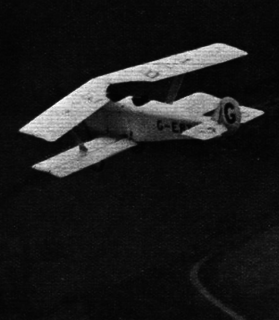
The Parnall Imp was an unusual single-engined, two-seat British biplane built in 1927. It had a straight cantilever lower wing which supported the markedly swept upper wing. Only one was built.
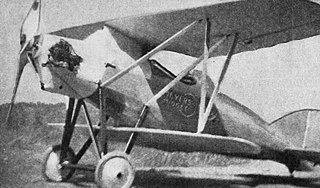
The Meyers Midget was a one-off small, low-powered, sporting single-seat sesquiplane, designed and built in the United States in 1926, incorporating several innovative structural features.
The Starck AS-37 is a two-seat biplane with unconventional wing and propulsion layouts. It was designed in France in the 1970s; though three were built and more than twenty sets of plans sold for home building, no AS-37s are active in 2012.
The Spijker V.3, sometimes anglicized to Spyker V.3 or Spyker-Trompenburg V.3, was a Dutch single-engine, single-seat biplane fighter, designed and built just before the end of World War I.

The Paalson Type 1, (Pålson), was a Swedish single-seat sport aircraft built around 1920. It was of conventional single-seat biplane layout but had some unusual features such as girder type interplane struts, a novel main undercarriage axle mounting and a mechanism allowing adjustment of the angle of incidence of the upper wing.

The Kondor D 6 was a prototype German biplane fighter aircraft flown in 1918. In the interests of better upward vision for the pilot, its upper wing was in two halves, separated over the central fuselage. Its development was soon abandoned.
The Letov Š-13 was a single-seat, single-engine fighter aircraft designed and built in Czechoslovakia in the early 1920s. A biplane, it had aerodynamically thick wings which were originally cantilever structures, though interplane struts were later added. Only one was produced.
The Hanriot HD.5 was a French two-seat fighter aircraft prototype, built towards the end of World War I. A single-engine biplane with an unusually narrow gap between the upper and lower wings, it did not enter production.

The Albatros L.71 was a two-seat, single pusher engined biplane built in Germany in the 1920s.

The Potez VIII was a French training aircraft which first flew in 1920. Originally it had a very unusual vertical inline engine and a four-wheeled undercarriage, though the production version was more conventional.
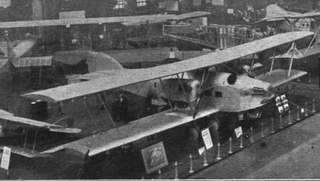
The Potez XVIII was a French airliner from the early 1920s, a three-engine biplane carrying up to twelve passengers.
The Potez 26 was a single seat fighter aircraft designed and flown in France in the mid-1920s. It did not reach production.
The Caudron C.251 Et-2 was a French tandem seat, open cockpit biplane designed as an intermediate trainer and built in 1931. It did not go into production.

The Heinkel HD 20 was a twin engine, three seat German biplane built in 1926 for civil survey work.
The Potez 24 A.2 was a mid-1920s French biplane intended to replace the Potez 15 as an army observation aircraft. The further improved and larger Potez 25 was preferred for production.

The Aerial Engineering Corporation Standard 6W-3 was a commercial transport modification of the US Standard J-1 biplane military trainer aircraft, with new wings, engine and accommodation for four passengers. First flown in 1925, it was built in small numbers.

The Dąbrowski D.1 Cykacz (Ticktock) was an unusual, small, low-powered, single-seat biplane, intended to provide wider access to flying. Though it was exceptionally aerodynamically clean, it was under-powered and had limited range. Only one was built.
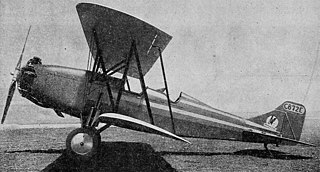
The American Eagle Phaeton was an American three seat, single engine sports biplane produced from 1929 until American Eagle failed financially in 1932. About 34 were built.
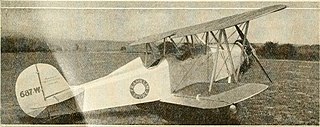
The Franklin Sport is a two seat sport and training biplane built in the U.S. in 1930. Several different engines, in the power range 55–90 hp (41–67 kW), were fitted. Two remained airworthy in 2011.
References
- ↑ "AS-20 image" . Retrieved 25 May 2012.
- ↑ "Nenadovitch effect" (PDF). Retrieved 21 May 2012.
- 1 2 3 Taylor, John W R (1978). Jane's All the World's Aircraft 1978-79. London: Jane's Yearbooks. p. 483. ISBN 0 35 400572 3.
- 1 2 3 4 5 "Private Flight". Flight . Vol. 109 no. 3486. 9 September 1926. pp. 30–1.